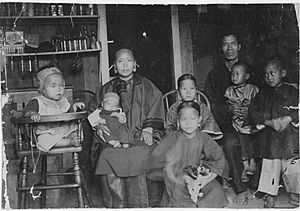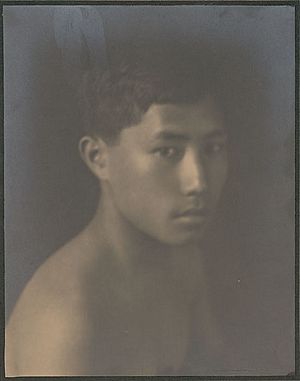Chinese immigration to Hawaii facts for kids
| Total population | |
|---|---|
| 198,711 (2010) | |
| Languages | |
| Cantonese, English, Hawaiian, Hakka | |
| Religion | |
| Roman Catholicism, Protestantism Buddhism, Confucianism, Taoism |
|
| Related ethnic groups | |
| Hakka Americans, Cantonese people |
The Chinese in Hawaiʻi are a group of people with Chinese heritage who live in Hawaiʻi. They make up about 4.7% of the state's population. Most of them (about 75%) are Cantonese people whose families came from Zhongshan in Guangdong, China.
This number does not include people who have both Chinese and Hawaiian ancestors. If you count everyone with Chinese family roots in Hawaiʻi, including those with mixed heritage, they make up about one-third of Hawaiʻi's total population. As citizens of the United States, they are part of the larger group known as Chinese Americans. A smaller number of Chinese in Hawaiʻi have Hakka family backgrounds.
History of Chinese in Hawaiʻi
Historical records show that Chinese people first arrived in Hawaiʻi in the late 1700s. A few sailors came in 1778 with Captain Cook. More arrived in 1788 with John Meares. Some came in 1789 with an American trader named Simon Metcalfe, who sailed to Maui from Macau. In 1794, Captain George Vancouver visited the islands and saw one Chinese resident.
From 1792 to about 1843, Hawaiʻi exported sandalwood to China. King Kamehameha I encouraged this trade. Because of the sandalwood, Chinese people called the Hawaiian Islands "Tan Heung Shan." This means "Fragrant Sandalwood Hills" in Cantonese.
Between 1852 and 1899, about 46,000 Chinese people moved to Hawaiʻi. By 1900, there were 25,767 Chinese people living there. Many of these early migrants were from Fujian and spoke Fukienese, not Cantonese. An American missionary in Maui in 1856 noticed that Chinese shopkeepers (mostly Cantonese) and laborers (mostly Fukienese) often spoke the Hawaiian language to each other.
Many Chinese immigrants first came to work on sugar plantations in Hawaii. However, they focused on getting a good education for their children. When their work contracts ended, many chose to stay in Hawaiʻi. They opened businesses in areas like Chinatown. By 1950, most Chinese American men in Hawaiʻi were well-educated and had good jobs. Today, about 95% of Chinese Americans in Hawaiʻi live in Honolulu.
A good number of early Chinese immigrants to Hawaiʻi were Hakka people. This was different from the mainland US, where fewer Hakka settled. In the first half of the 1800s, about 30% of Chinese in Hawaiʻi were Hakka. On the West Coast of the US, only about 3% were Hakka. A big wave of immigration happened after an 1876 agreement between the US and the Kingdom of Hawaii. This agreement led to a greater need for workers.
Many Chinese men in Hawaiʻi married women from other backgrounds. For example, many Chinese men married Portuguese women. These marriages led to children with mixed Chinese and Portuguese heritage. Over time, Chinese men also married women of Hawaiian, Japanese, and other European backgrounds. This helped create a rich mix of cultures in Hawaiʻi.
Religion
Before Christian missionaries came to Hawaiʻi, the first Chinese settlers followed religions like Buddhism, Taoism, and Confucianism. Some even mixed parts of native Hawaiian beliefs into their own traditions.
Today, many Chinese in Hawaiʻi are Christians. This is because of the work of Christian missionaries in the late 1800s and 1900s. They belong to Protestant and Roman Catholic churches. However, about 100 Buddhist and ancestral temples still exist. Some people who follow traditional Chinese religions visit these temples every year to honor their ancestors. It is hard to know the exact number of people who follow each religion within the Chinese community in Hawaiʻi.
Notable Chinese people from Hawaiʻi
- Chun Afong
- Daniel K. Akaka
- Joseph Apukai Akina
- Chang Apana
- Brian Ching
- Madison Chock
- Norm Chow
- William K.S. Chow
- Sam Choy
- Kam-Fong Chun
- Gordon Pai'ea Chung-Hoon
- Auliʻi Cravalho
- Hiram L. Fong
- Clayton Hee
- Don Ho
- Hoku Ho
- Kelly Hu
- Jason Scott Lee
- Richard Loo
- Tai Sing Loo
- Agnes Lum
- William S. Richardson
- Logan Tom
See also
 In Spanish: Inmigración china en Hawái para niños
In Spanish: Inmigración china en Hawái para niños



